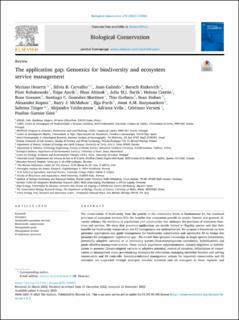| dc.identifier.citation | Heuertz, M., Carvalho, S. B., Galindo, J., Rinkevich, B., Robakowski, P., Aavik, T., Altinok, I., Barth, J. M. I., Cotrim, H., Goessen, R., González-Martínez, S. C., Grebenc, T., Hoban, S., Kopatz, A., McMahon, B. J., Porth, I., Raeymaekers, J. A. M., Träger, S., Valdecantos, A., Vella, A., Vernesi, C., & Garnier-Géré, P. (2023). The application gap: Genomics for biodiversity and ecosystem service management. Biological Conservation, 278, Article 109883. doi: | en_US |
| dc.description.abstract | The conservation of biodiversity from the genetic to the community levels is fundamental for the continual provision of ecosystem services (ES), the benefits that ecosystems provide to people. Genetic and genomic diversity enhance the resilience of populations and communities that underpin the provision of ecosystem functions and services. We show that genomics applications are mostly limited to flagship species and that their benefits for biodiversity conservation and ES management are underachieved. We propose a framework on how genomics applications can guide management for biodiversity conservation and sustainable ES to bridge this genomics-ES management ‘application gap’. We review how genomic knowledge in single species (relatedness, potentially adaptive variants) or in interacting species (host-microorganism coevolution, hybridization) can guide effective management actions. These include population supplementation, assisted migration or hybridization to promote climate-adapted variants or adaptive potential, control of invasives, delimitation of conservation or management areas, provenancing strategies for restoration, managing microbial function and solving conservation and ES trade-offs. Genomics-informed management actions for improved conservation and ES outcomes are supported through synergies between scientists and ES managers at local, regional and international levels, through the development of standardized genomic workflows, training to ES managers and incorporation of local information. Such actions facilitate the implementation of biodiversity conservation and ES policies such as the UN 2030 sustainable development goals and the EU Biodiversity strategy for 2030, and support the inclusion of ambitious biodiversity conservation goals in the development of new policies such as the CBD post-2020 Global Biodiversity Framework or conservation policies on hybrids. Genomics Sustainable ecosystem services Biodiversity conservation Management goals Management actions Evolutionary processes | en_US |

